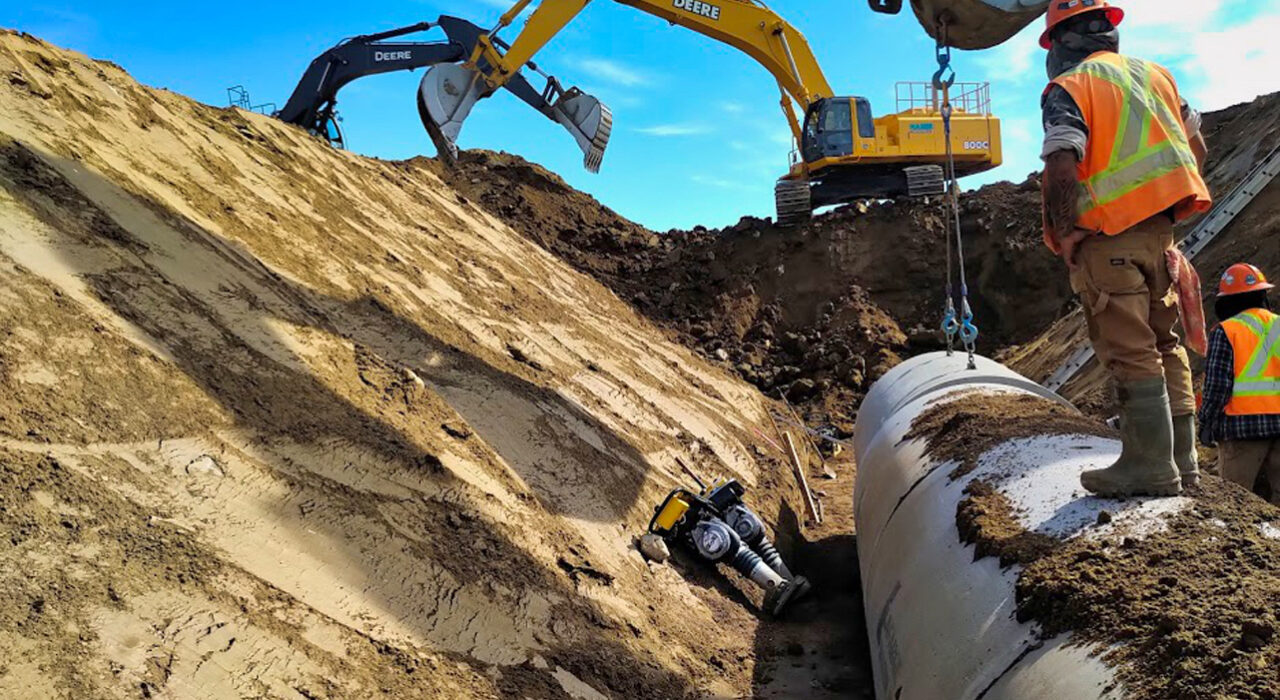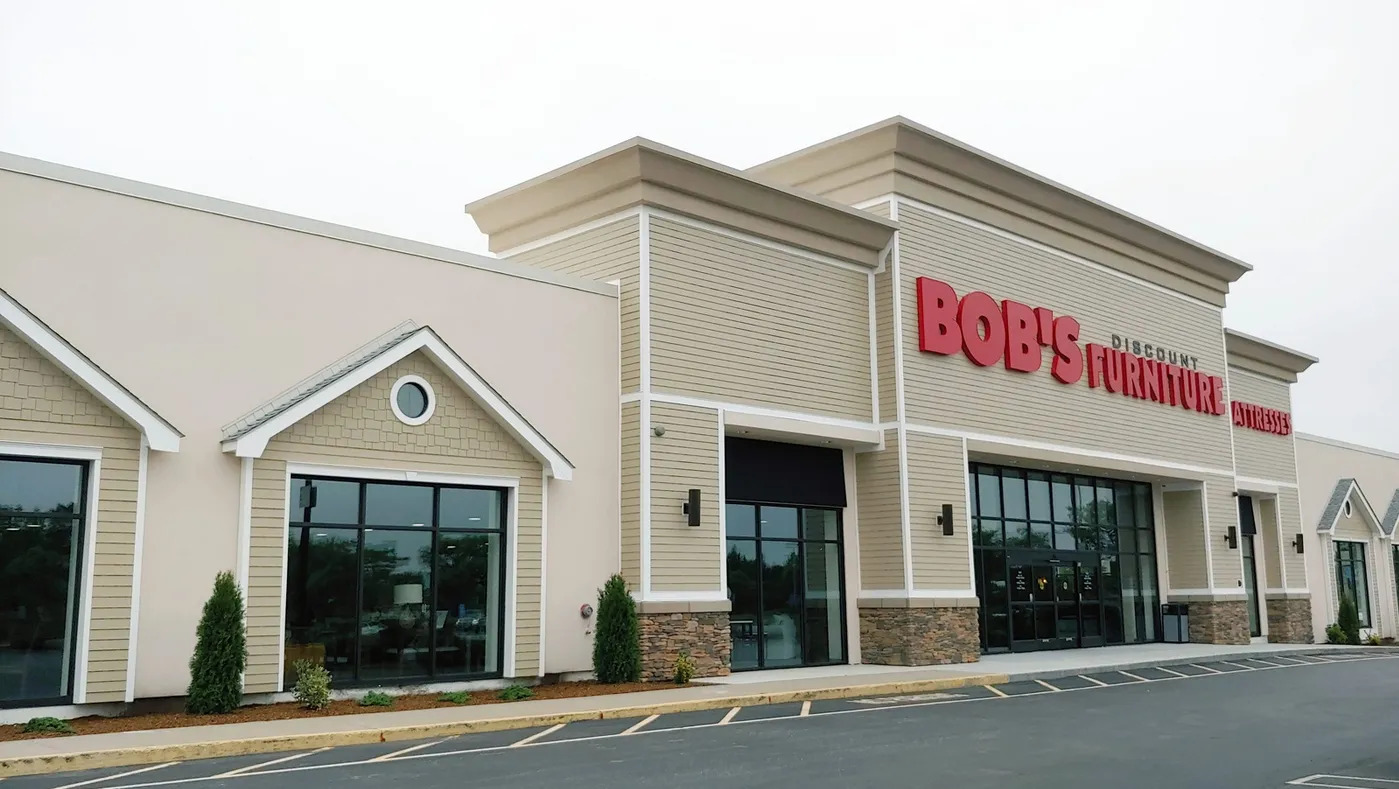Home>diy>Building & Construction>Who Owns Hamm Construction


Building & Construction
Who Owns Hamm Construction
Modified: March 6, 2024
Find out who owns Hamm Construction, a leading company in the building construction industry.
(Many of the links in this article redirect to a specific reviewed product. Your purchase of these products through affiliate links helps to generate commission for Storables.com, at no extra cost. Learn more)
Introduction
In the fast-paced and ever-evolving world of construction, it is essential to have a clear understanding of who owns and operates the companies responsible for building the infrastructure that surrounds us. In this article, we delve into the fascinating world of Hamm Construction and explore its ownership structure.
Hamm Construction is a renowned and well-established construction company that has left an indelible mark on the industry. From towering skyscrapers to intricate bridge structures, Hamm Construction has consistently delivered exceptional projects, earning them a reputation for excellence and reliability.
Understanding the ownership structure of a construction company is crucial as it can shed light on the decision-making processes, the company’s values, and future prospects. So, who actually owns Hamm Construction?
Read on as we take a closer look at the founders, the changes in ownership over the years, the current ownership structure, the key shareholders, and the impact of ownership on Hamm Construction’s operations.
Key Takeaways:
- Hamm Construction’s ownership has evolved from its visionary founders to strategic partnerships and a management buyout, shaping its operations and commitment to excellence.
- The current ownership structure of Hamm Construction includes key executives and strategic investors, driving innovation, client-centric approach, and a commitment to safety and ethical conduct.
Read more: Who Owns Sterling Construction
Hamm Construction: A Brief Overview
Hamm Construction, founded in 1965, has emerged as a industry leader in the construction sector. With over five decades of experience in the field, the company has established a reputation for delivering high-quality projects across various sectors, including commercial, residential, industrial, and infrastructure.
Under the guidance of its visionary founders, John Hamm and Robert Johnson, Hamm Construction quickly gained recognition for its commitment to excellence and its ability to execute projects with precision. The company’s early projects showcased their expertise in constructing state-of-the-art buildings that met the demands of a growing and evolving market.
Throughout the years, Hamm Construction has successfully undertaken numerous landmark projects, always staying at the forefront of the industry by implementing innovative construction techniques and utilizing the latest technologies. These achievements have positioned Hamm Construction as a go-to choice for clients seeking top-tier construction services.
Beyond its impressive portfolio, Hamm Construction has also earned accolades for its commitment to safety and sustainable practices. The company prides itself on adhering to strict safety guidelines to protect its employees and contractors on every job site. Additionally, Hamm Construction integrates sustainable construction practices to minimize its environmental impact and contribute to a greener future.
With a track record of success and a team of highly skilled professionals, Hamm Construction continues to thrive in a competitive market. But who owns Hamm Construction, and how has the ownership evolved over the years? Let’s delve into the details.
The Founders and Initial Ownership
The story of Hamm Construction begins with its two visionary founders, John Hamm and Robert Johnson. These two individuals, driven by a shared passion for construction and an unwavering commitment to quality, came together in 1965 to establish the company.
Both Hamm and Johnson brought their unique skills and expertise to the table, which laid the foundation for the company’s early success. Hamm, with his exceptional project management abilities, and Johnson, with his deep knowledge of structural engineering, created a winning combination that propelled the company forward.
Initially, Hamm and Johnson owned and operated the company as equal partners. Their dedication to delivering exceptional projects, coupled with their ability to forge strong relationships with clients, enabled Hamm Construction to secure contracts and gain a foothold in the industry.
As the company grew, Hamm and Johnson made it a point to surround themselves with a talented team of professionals who shared their vision and values. This collaborative approach fostered a culture of innovation and excellence that became a hallmark of Hamm Construction.
Over time, the company’s reputation grew, leading to significant growth opportunities. As Hamm Construction took on larger and more complex projects, the need for additional resources and capital arose. To fuel this expansion, Hamm and Johnson made a strategic decision to bring in external investors.
Through careful evaluation and vetting processes, Hamm Construction welcomed a select group of investors on board. These investors, who believed in the company’s vision and potential, injected the necessary capital and expertise to support its growth trajectory.
While Hamm and Johnson maintained their majority ownership, the investors held minority stakes in the company. This approach allowed Hamm Construction to strike a perfect balance between retaining control of the company’s operations and tapping into the valuable resources and insights provided by the investors.
It is important to note that Hamm Construction has always remained true to its core values and principles. Despite the changes in ownership, the company has stayed committed to delivering exceptional craftsmanship, maintaining strong client relationships, and prioritizing the well-being of its employees.
As we move forward, let’s explore how the ownership structure of Hamm Construction has evolved over the years and the key shareholders who are involved in shaping the company’s future.
Changes in Ownership over the Years
Like most successful companies, Hamm Construction has undergone changes in its ownership structure throughout its history. These changes have been driven by various factors, including the company’s growth, the need for additional resources, and strategic partnerships.
As Hamm Construction continued to establish itself as a leader in the construction industry, the founders, John Hamm and Robert Johnson, saw the potential for expansion and recognized the importance of securing additional capital to fuel growth. In the early 1980s, Hamm Construction entered into a strategic partnership with a larger construction conglomerate, which resulted in a shift in ownership.
Under the new ownership structure, the conglomerate acquired a majority stake in Hamm Construction, while Hamm and Johnson retained minority ownership. This change in ownership provided Hamm Construction with access to greater resources, including advanced technologies, increased financial backing, and a broader client network.
While the shift in ownership brought new opportunities for Hamm Construction, it also presented challenges. The company had to navigate the intricacies of working within a larger corporate structure while preserving its core values and maintaining the quality that had made it successful.
In the 1990s, Hamm Construction underwent another significant change in ownership. A management buyout took place, led by key executives within the company. This buyout resulted in Hamm Construction becoming an independent entity once again, with ownership being transferred back to those individuals who had been instrumental in the company’s success.
This change in ownership allowed Hamm Construction to regain control of its operations and refocus on its core principles. With a renewed sense of independence, the company was able to align its strategies and decision-making processes more closely with its original vision and values.
Since then, Hamm Construction has maintained its status as an independent construction company, with ownership primarily held by key executives and a select group of investors who continue to believe in the company’s potential for growth and success.
It is worth mentioning that throughout these changes in ownership, Hamm Construction has managed to retain its reputation for excellence and reliability. The company has been able to adapt to new ownership structures while remaining committed to delivering exceptional projects and maintaining strong client relationships.
Now that we have explored the changes in ownership that Hamm Construction has experienced over the years, let’s delve into the current ownership structure and the key shareholders who play a role in shaping the company’s future.
Check the company’s official website or look for their information on business databases like Dun & Bradstreet to find out the ownership of Hamm Construction.
Current Ownership Structure
The current ownership structure of Hamm Construction reflects a balance between key executives and strategic investors who are committed to the company’s growth and success. While specific ownership percentages may vary, the overall structure ensures that the company has a solid foundation to continue its operations and pursue new opportunities.
At the helm of Hamm Construction are a group of dedicated executives who have been with the company for many years and possess invaluable industry expertise. These executives, who hold leadership positions, play a crucial role in overseeing the day-to-day operations and guiding the company’s strategic direction.
In addition to the key executives, Hamm Construction has a select group of strategic investors who have made significant investments in the company. These investors bring not only financial resources but also a wealth of industry knowledge and connections. Their presence as stakeholders ensures that Hamm Construction can leverage their expertise to seize new opportunities and maintain a competitive edge.
The current ownership structure is designed to promote collaboration and decision-making processes that align with Hamm Construction’s values and goals. The executives and investors work together to chart the company’s future course, with a focus on sustainable growth and delivering exceptional value to clients.
One of the key advantages of the current ownership structure is that it allows Hamm Construction to remain agile and adaptable in a rapidly changing industry. By leveraging the diverse insights and perspectives of both the executives and the investors, the company can identify emerging trends, explore new markets, and invest in innovative technologies.
Moreover, the ownership structure emphasizes the importance of maintaining strong client relationships and delivering projects of the highest quality. This customer-centric approach remains at the core of Hamm Construction’s values and is a driving force behind its continued success.
As Hamm Construction looks toward the future, the company remains committed to maintaining a transparent and collaborative ownership structure. By fostering a culture of shared responsibility and open communication, Hamm Construction ensures that all stakeholders have a voice in shaping the company’s direction and addressing challenges as they arise.
By carefully balancing the ownership structure with a focus on expertise, financial backing, and strategic partnerships, Hamm Construction is well-positioned to thrive in the construction industry and continue building a legacy of excellence.
Having explored the current ownership structure of Hamm Construction, let’s now turn our attention to the key shareholders and their influence on the company’s operations.
Key Shareholders and Their Influence
Hamm Construction’s ownership structure includes a group of key shareholders who play a significant role in the company’s operations and overall decision-making processes. These shareholders bring a variety of expertise, resources, and perspectives, which contribute to the company’s success and future growth.
While the specifics of ownership percentages may vary, the key shareholders typically include executives, key employees, and strategic investors who have made substantial investments in Hamm Construction.
The executives, who often have a deep understanding of the company’s day-to-day operations, hold a significant stake in Hamm Construction. Their influence stems from their extensive experience in the construction industry, as well as their comprehensive knowledge of the company’s internal dynamics and strategic priorities. These executives provide valuable insights and leadership, shaping the company’s overall direction and ensuring operational efficiency.
In addition to the executives, key employees who have demonstrated exceptional dedication and expertise may also hold shares in Hamm Construction. These individuals often possess specialized skills and domain knowledge that contribute to the company’s success in specific areas, such as project management, engineering, or procurement. Their influence on the company’s operations is derived from their hands-on involvement in critical projects and their ability to drive innovation and excellence.
Strategic investors likewise have a significant influence on Hamm Construction’s decision-making processes. These investors bring financial resources, industry connections, and business acumen, all of which are critical for the company’s growth and long-term sustainability. Their expertise and perspectives help shape strategic initiatives, guide expansion plans, and identify opportunities for innovation. Furthermore, strategic investors often offer valuable insights into market trends and industry best practices, allowing Hamm Construction to stay ahead of the competition.
Ultimately, the key shareholders, whether executives, key employees, or strategic investors, collectively contribute to Hamm Construction’s success by providing a diverse range of expertise, resources, and perspectives. Their influence is felt throughout various aspects of the company, including strategic planning, project execution, talent development, and client relationships.
It is worth noting that Hamm Construction’s corporate governance framework ensures that the influence of key shareholders is exercised within a framework of accountability and transparency. Regular board meetings, open communication channels, and well-defined decision-making processes help foster a culture of shared responsibility and ensure that the interests of all stakeholders are considered.
By leveraging the strengths and expertise of its key shareholders, Hamm Construction continues to build upon its industry reputation and deliver exceptional results. The collaborative nature of the ownership structure allows for effective decision-making, adaptability to market changes, and a client-centric approach that drives the company’s continued success.
Now that we have explored the key shareholders and their influence, let’s examine the impact of ownership on Hamm Construction’s operations.
Impact of Ownership on Hamm Construction’s OperationsThe ownership structure of Hamm Construction plays a crucial role in shaping the company’s operations and overall success. The combination of key executives, employees, and strategic investors influences various aspects of the company’s operations, resulting in a dynamic and effective organization.
One of the primary impacts of ownership on Hamm Construction’s operations is the ability to access additional resources and expertise. With the support of strategic investors, the company can leverage their financial backing to undertake larger and more complex projects. The investors’ industry knowledge and connections also provide valuable insights, enabling Hamm Construction to stay at the forefront of technological advancements, construction methodologies, and market trends.
The ownership structure also fosters a culture of collaboration and innovation within Hamm Construction. The involvement of key executives and employees as shareholders encourages a sense of ownership and entrepreneurial spirit. This drives creativity and a commitment to delivering exceptional work, as each individual has a vested interest in the company’s success. The combination of diverse perspectives and expertise leads to innovative solutions, improved project management, and streamlined operations.
Furthermore, ownership influences the strategic decision-making processes of Hamm Construction. The key shareholders, particularly executives and strategic investors, contribute their insights and industry expertise when shaping the company’s overall direction. They analyze market conditions, identify growth opportunities, and determine the most effective strategies to secure new projects and expand into new markets. This collaborative decision-making approach ensures that Hamm Construction remains agile, adaptable, and aligned with its long-term goals.
Ownership also has a significant impact on the company’s approach to client relationships and project execution. The shared commitment to excellence among key shareholders manifests in a customer-centric approach. Hamm Construction strives to exceed client expectations, delivering high-quality projects on time and within budget. The strong ownership structure ensures that decision-making is focused on client satisfaction and maintaining the company’s reputation for reliability and professionalism.
Moreover, ownership influences the company’s commitment to safety practices and ethical conduct. The key shareholders have a vested interest in protecting the well-being of employees, contractors, and the community at large. By prioritizing safety and maintaining high ethical standards, Hamm Construction creates a positive work environment and fosters trust among its stakeholders.
In summary, the ownership structure of Hamm Construction has a profound impact on its operations. It provides access to additional resources, fosters a collaborative and innovative culture, influences strategic decision-making, enhances client relationships, and promotes a commitment to safety and ethical conduct. These factors collectively contribute to Hamm Construction’s ability to deliver exceptional projects, adapt to market changes, and maintain its position as a leader in the construction industry.
Having explored the impact of ownership on Hamm Construction’s operations, we can conclude that the ownership structure is a critical component of the company’s success and serves as a strong foundation for its continued growth and excellence.
Do you need any further assistance?
Conclusion
In conclusion, understanding the ownership structure of a construction company like Hamm Construction provides valuable insights into its operations, decision-making processes, and overall success. Founded by John Hamm and Robert Johnson, Hamm Construction has grown and evolved over the years, guided by a commitment to excellence and a passion for delivering exceptional construction projects.
The ownership structure of Hamm Construction has undergone changes throughout its history, reflecting the company’s growth and strategic partnerships. From the initial founders, the company transitioned to ownership by a larger construction conglomerate before eventually returning to independent ownership through a management buyout.
The current ownership structure of Hamm Construction is a dynamic combination of key executives, employees, and strategic investors. This blend of expertise and resources influences the company’s operations in several ways. The involvement of key executives ensures a deep understanding of the industry and facilitates effective decision-making. Strategic investors contribute financial backing, industry knowledge, and connections, giving Hamm Construction a competitive edge.
The impact of ownership on Hamm Construction’s operations is significant. It enables the company to access additional resources and expertise, fostering innovation, and driving efficiency. The collaboration between key shareholders results in strategic decisions that align with the company’s values and long-term goals. It also strengthens client relationships and emphasizes a customer-centric approach. Moreover, ownership influences Hamm Construction’s commitment to safety and ethical conduct, creating a positive work environment.
In summary, the ownership structure of Hamm Construction plays a vital role in shaping its operations, driving growth, and ensuring success in the ever-evolving construction industry. The inclusive and collaborative approach of key executives, employees, and strategic investors empowers Hamm Construction to deliver exceptional projects, adapt to market changes, and maintain a reputation for excellence and reliability.
As Hamm Construction looks to the future, its ownership structure will continue to be a critical component in driving the company’s growth, innovation, and success. Through a combination of industry expertise, financial backing, and a shared commitment to excellence, Hamm Construction is well-positioned to navigate the challenges of the construction industry and continue to leave a lasting impact on the built environment.
Thank you for joining us on this exploration of Hamm Construction’s ownership structure. If you have any further questions or require additional information, please don’t hesitate to reach out.
Frequently Asked Questions about Who Owns Hamm Construction
Was this page helpful?
At Storables.com, we guarantee accurate and reliable information. Our content, validated by Expert Board Contributors, is crafted following stringent Editorial Policies. We're committed to providing you with well-researched, expert-backed insights for all your informational needs.















0 thoughts on “Who Owns Hamm Construction”